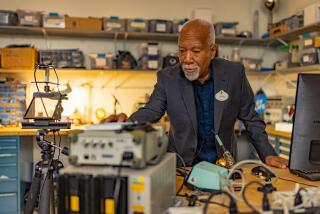How Bill Seidel Started the Unball Rolling
- Share via
Inventor Thomas Edison wasn’t kidding when he said genius is 1% inspiration, 99% perspiration. Bill Seidel has sweated enough over his ingenious ideas to know that.
It took the California inventor four months and hundreds of discarded prototypes to come up with the lumpy, leather marvel he calls the Unball--and that was just the beginning. The sandy-haired industrial designer labored 10 more years trying to market his 1975 creation before it became a mild sensation this year.
Seidel’s 3-year-old firm, Unball Inc., has sold more than 50,000 units since February, when the invention won an honorable mention at the New York Toy Fair and, subsequently, national contracts with Toys ‘R’ Us and Lionel Playworld.
Not a Lucky Shot
His entrepreneurial experience, though atypical in its success, shows the hard work that often goes into making and marketing the products that elbow their way onto department-store shelves.
The idea for the Unball--essentially a deformed softball with a crushed-leather interior--emerged when Seidel, then working for a clothing company, took a look at the mountains of scrap leather piled up in the firm’s factories. “They didn’t know what to do with it all,” he muses. “There were only so many elbow patches and key chains you could make.”
But coming up with the stylish “soft-tech” item “wasn’t just a lucky shot,” Seidel says. “I went through 400 prototypes to come up with this pattern.” He adds, “I was looking for a ball that was soft and didn’t roll,” so it wouldn’t hurt to get hit--or hurtle into the street after an errant throw.
Months later, when he thumped one of his simplest prototypes into his hand, it felt so natural--”like catching a baseball, but without the glove,” he says--that he knew he had a bright idea.
For Seidel, now an instructor in industrial design at San Francisco State, the flash of inventive inspiration--however brief--usually comes from “looking at the same things everyone else does and seeing something different,” he explains, echoing one of Albert Einstein’s less-scientific postulations.
Two of his current projects also bear the aphorism out. One was sparked when he was trying in vain to install car stereo components in a hard-to-reach nook behind his dashboard. He turned that familiar frustration into a simple but creative idea--tools you can attach to the end of your finger. In another project, which he labels “top secret,” Seidel is creating what he calls “a revolution in speaker design”--a speaker system that somehow adjusts the acoustics of the room to fit the sound, instead of vice versa.
‘Now What Do You Do?’
“Breaking rules is fine when you’re dealing with discovery,” Seidel says. He recalls how--as a 10-year-old--he broke house rules by putting speakers in the air ducts to broadcast music around the house. “The sound quality didn’t turn out so great,” he says, “but it was easier than running wires through the house.”
In most discoveries, however, “the illumination is not much,” he says. “It lights up; you see the answer. Now what do you do?”
Patent your idea, many inventors would say. Seidel agrees that’s a necessary step. But “a patent has absolutely nothing to do with success,” he says, noting that only one in 10 patented products ever make it to market.
The San Anselmo inventor says that “the biggest stumbling block for inventors is marketing.” He’s been tripped up enough times to know. After two marketing offensives for the Unball--both doomed for lack of money and focus, he says--Seidel decided that he was “too close to the idea; realized that I had to cut the umbilical cord.”
A Spawning Ground
So in the spring of 1980 he enrolled in a course called “How to Patent, Market, and Develop your Idea” at San Francisco State--and did so well that he now helps teach it. The class, which has for 22 years been a spawning ground for such inventions as the water bed and quadrophonic sound, is now more of a marketing springboard for ideas. Each semester the class attracts about 35 students with ideas ranging from--to take Siedel’s spring semester class as an example--a “better” golf tee to a “better” method of brain surgery.
Along with a 100-page business plan and a concise executive summary with realistic projections, Seidel came out of the class armed with new confidence to sell his idea and, more important, himself. (“Investors invest in four things,” he observes, only half-jokingly, “people, people, people and an idea.”)
More to Read
Inside the business of entertainment
The Wide Shot brings you news, analysis and insights on everything from streaming wars to production — and what it all means for the future.
You may occasionally receive promotional content from the Los Angeles Times.










